Pumping Station Desing - Second Edition by Robert L. Sanks, George Tchobahoglous, Garr M. Jones
Подождите немного. Документ загружается.

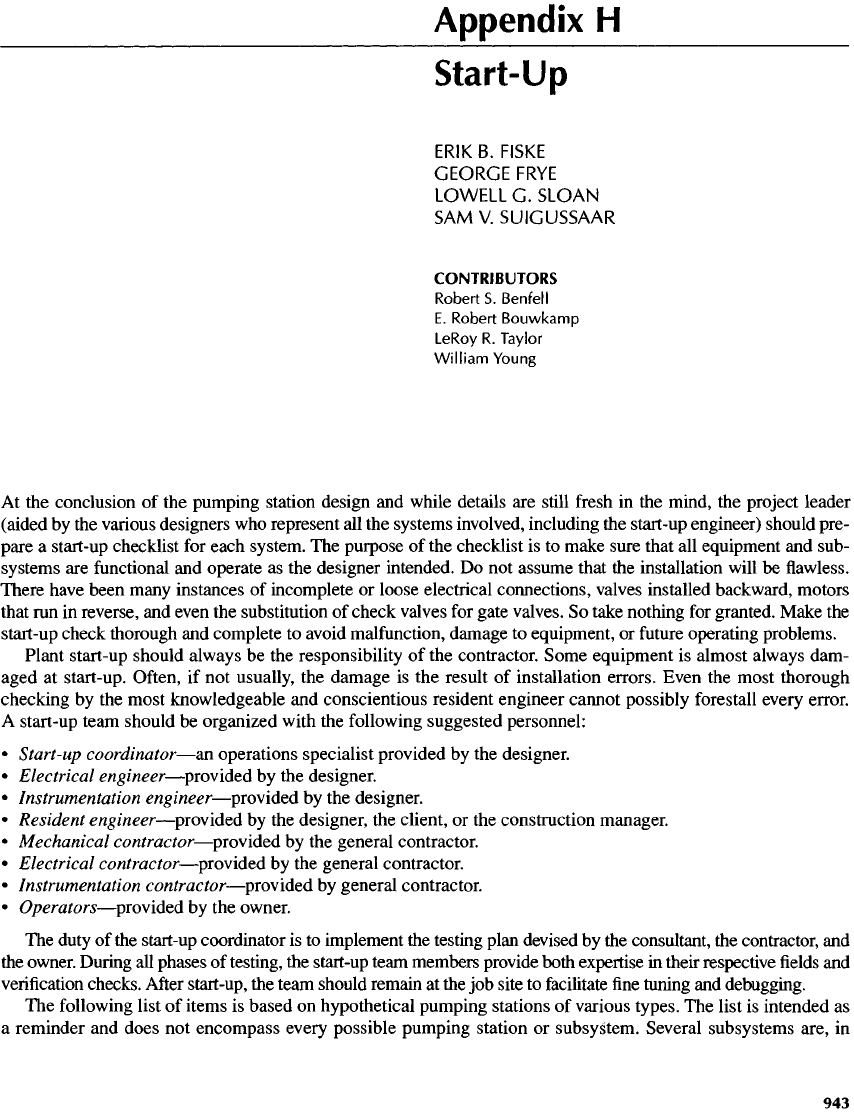
Appendix
H
Start-Up
ERIK
B.
FISKE
GEORGE
FRYE
LOWELL
G.
SLOAN
SAM V.
SUIGUSSAAR
CONTRIBUTORS
Roberts.
Benfell
E.
Robert
Bouwkamp
LeRoy
R.
Taylor
William
Young
At
the
conclusion
of the
pumping station design
and
while details
are
still
fresh
in the
mind,
the
project leader
(aided
by the
various designers
who
represent
all the
systems involved, including
the
start-up engineer) should pre-
pare
a
start-up checklist
for
each system.
The
purpose
of the
checklist
is to
make sure that
all
equipment
and
sub-
systems
are
functional
and
operate
as the
designer intended.
Do not
assume that
the
installation will
be flawless.
There have been many instances
of
incomplete
or
loose electrical connections, valves installed backward, motors
that
run in
reverse,
and
even
the
substitution
of
check valves
for
gate valves.
So
take nothing
for
granted. Make
the
start-up
check thorough
and
complete
to
avoid malfunction, damage
to
equipment,
or
future
operating problems.
Plant start-up should always
be the
responsibility
of the
contractor. Some equipment
is
almost always dam-
aged
at
start-up.
Often,
if not
usually,
the
damage
is the
result
of
installation
errors.
Even
the
most thorough
checking
by the
most knowledgeable
and
conscientious resident engineer cannot possibly forestall every error.
A
start-up team should
be
organized with
the
following suggested personnel:
•
Start-up
coordinator—an
operations specialist provided
by the
designer.
•
Electrical
engineer—provided
by the
designer.
•
Instrumentation
engineer—provided
by the
designer.
•
Resident
engineer—provided
by the
designer,
the
client,
or the
construction manager.
•
Mechanical
contractor—provided
by the
general contractor.
•
Electrical
contractor—provided
by the
general contractor.
•
Instrumentation
contractor—provided
by
general contractor.
•
Operators—provided
by the
owner.
The
duty
of the
start-up coordinator
is to
implement
the
testing plan devised
by the
consultant,
the
contractor,
and
the
owner. During
all
phases
of
testing,
the
start-up team members provide both expertise
in
their respective
fields
and
verification
checks.
After
start-up,
the
team should remain
at the job
site
to
facilitate
fine
tuning
and
debugging.
The
following
list
of
items
is
based
on
hypothetical pumping stations
of
various types.
The
list
is
intended
as
a
reminder
and
does
not
encompass every possible pumping station
or
subsystem. Several subsystems
are,
in

fact,
omitted.
For
example, ventilation,
gas
detection
(Cl
2
,
H
2
S,
explosive gases), emergency generator, odor
control,
and fluid
power systems
are so
specialized
or
specific
as to
type
and
manufacturer that
a
generalized list
might
be
inappropriate. Some parts
of the
following
list
are
generic,
and
some
are
detailed
to
emphasize
the
complexity
and the
completeness needed
for
start-up.
The
point
to be
emphasized
is
that start-up checklists
should
be
made with meticulous care
and
must
be
specific
to
each individual pumping station
and
each individ-
ual
system.
The
distinction among design, start-up,
and
troubleshooting checks
is
often
ill-defined.
The
troubleshooting
tips given
on
pages
145-148, 197-207,
and
288-292
of
Hydraulic Institute Standards
[1],
in
Table
9-1 of the
classic Pumping Manual
[2],
or on
pages
2.294-2.301
and
12.16-12.8
of
Karrasik
et
al.
[3] may
well
be
adapt-
able
to
start-up.
H-1.
Pre-Visit
Check
Before
visiting
the
pumping station, review
the
specifications, plans,
O&M
manual (control section),
and
manu-
facturers'
submittal data. Review
the
following application data.
Item
1.
Curves. System
H-Q
and
pump
performance
2.
Liquid pumped
3.
Capacity
4.
Pump mounting
5.
Number
of
pumps
and
operation strategy
(from
O&M
manual)
6.
Pump suction
7.
Pump discharge
o.
Power transmission
9.
Other power
considerations
10.
Piping
11.
Discharge check
12.
Shop tests
13.
Wet
well
Notes
Speeds, maximum heads
and
capacities,
and
design conditions.
Chemistry
of
liquid, temperature, specific gravity,
pH,
solids.
Station
influent
flow
rates, discharge rates,
and
pressure heads.
Horizontal, vertical,
or
suspended.
Sequencing, types
of
drivers
(C/S
or V/S or
combinations such
as 2 V/S and 1
C/S).
Wet
well head
or
lift
referred
to
pump datum point.
NPSH
A
versus
NPSH
R
.
Total head
in
feed
and
pounds
per
square inch
or the SI
equivalents. Obtain
the
required
time
to
close discharge valve
to
avoid water hammer.
Direct shaft-mounted coupling, intermediate
shaft,
vee-belt
drive,
etc.
Speed, motor overloading, motor
efficiency
and
power factor, station voltage, station
electrical systems
(one
or two
incoming lines
or
engine-generator power),
switchgear,
transformers,
induction
or
synchronous motors. Compare drive starting torque
to
pump
shut-off
torque,
and
effective
pumping volume versus motor
starts/hour
(responsibility
of
designer).
Flexible connections, base elbow, pipe supports, discharge air-release valve with drain
and
air
gap.
Air,
oil,
air-oil,
or
water with speed control, swing with valves spring
or
weight
and
lever,
etc.
Certified
or
witnessed. Shop test performance data that indicates speeds,
safe
(limit
lines) operating conditions,
and
NSPH
R
.
Low
wet
well level must
be
higher than
the
pump casing
and
there must
be no
vortexing
or
influent
waterfall
effect.
Otherwise,
furnish
an
automatic primer system.
[Ed.
note
—
including
such
a
feature
is the
designer's
responsibility.]
H-2. Pre-Start-Up Check
Before
start-up
of any
equipment, inspect
the
pumping station with
the
contractor,
and the
mechanical,
electrical,
and
instrumentation personnel.
The
start-up
of
complex equipment (such
as
engine-generator sets
and
variable-
speed controls) requires
a
factory representative,
so
coordinate
his
visit,
and let him
take
the
responsibility
for
his
equipment
(to
keep
manufacturers' warranties
in
force). Make sure
the
following items have been accom-
plished.
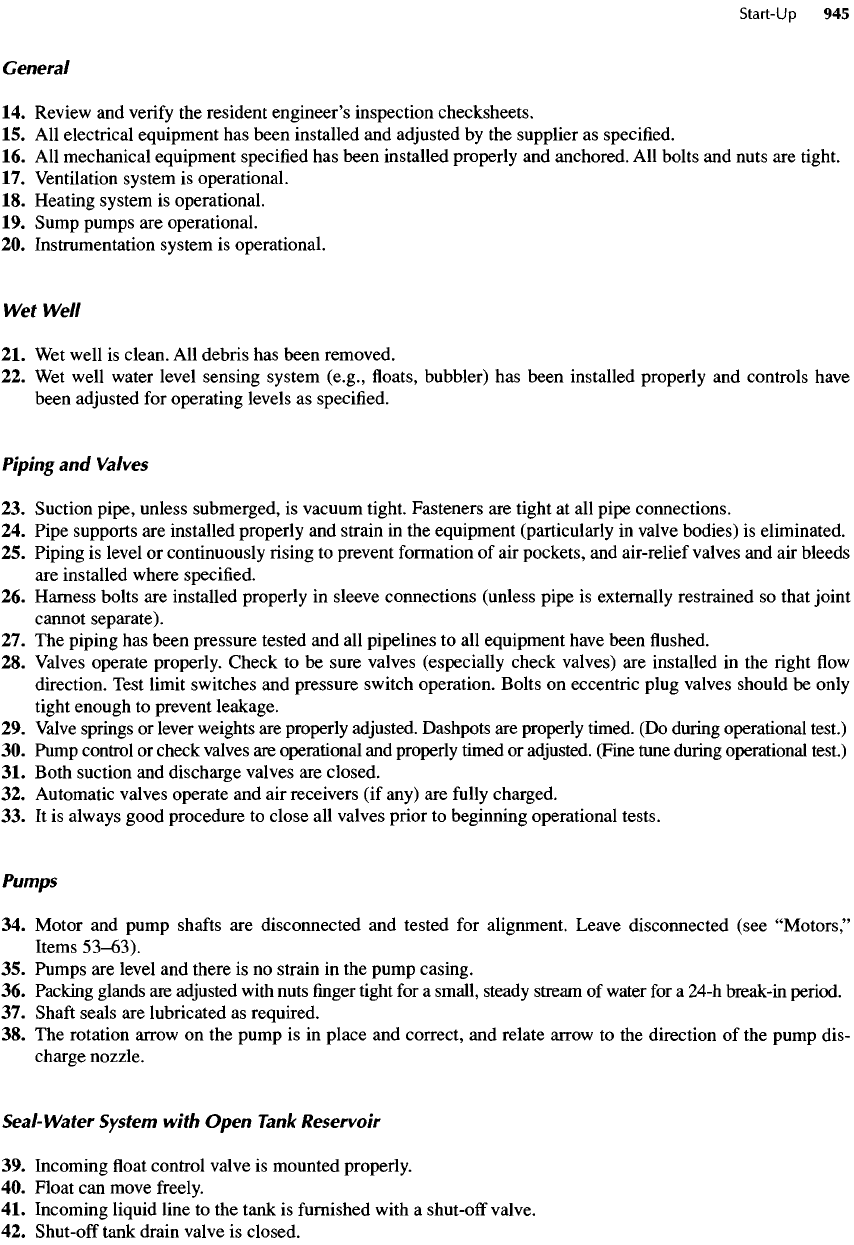
General
14.
Review
and
verify
the
resident
engineer's
inspection
checksheets.
15. All
electrical equipment
has
been installed
and
adjusted
by the
supplier
as
specified.
16. All
mechanical equipment specified
has
been installed properly
and
anchored.
All
bolts
and
nuts
are
tight.
17.
Ventilation system
is
operational.
18.
Heating system
is
operational.
19.
Sump pumps
are
operational.
20.
Instrumentation system
is
operational.
Wet
Well
21. Wet
well
is
clean.
All
debris
has
been removed.
22. Wet
well water level sensing system (e.g.,
floats,
bubbler)
has
been installed properly
and
controls have
been
adjusted
for
operating levels
as
specified.
Piping
and
Valves
23.
Suction pipe, unless submerged,
is
vacuum tight. Fasteners
are
tight
at all
pipe connections.
24.
Pipe supports
are
installed properly
and
strain
in the
equipment (particularly
in
valve bodies)
is
eliminated.
25.
Piping
is
level
or
continuously
rising to
prevent formation
of air
pockets,
and
air-relief valves
and air
bleeds
are
installed where
specified.
26.
Harness bolts
are
installed properly
in
sleeve connections (unless pipe
is
externally restrained
so
that joint
cannot
separate).
27. The
piping
has
been pressure tested
and all
pipelines
to all
equipment have been
flushed.
28.
Valves operate properly. Check
to be
sure valves (especially check valves)
are
installed
in the right flow
direction. Test limit switches
and
pressure switch operation. Bolts
on
eccentric plug valves should
be
only
tight
enough
to
prevent leakage.
29.
Valve
springs
or
lever weights
are
properly
adjusted.
Dashpots
are
properly timed.
(Do
during operational test.)
30.
Pump control
or
check valves
are
operational
and
properly timed
or
adjusted.
(Fine tune during operational test.)
31.
Both suction
and
discharge valves
are
closed.
32.
Automatic valves operate
and air
receivers
(if
any)
are
fully
charged.
33. It is
always good procedure
to
close
all
valves prior
to
beginning operational tests.
Pumps
34.
Motor
and
pump
shafts
are
disconnected
and
tested
for
alignment. Leave disconnected (see
"Motors,"
Items
53-63).
35.
Pumps
are
level
and
there
is no
strain
in the
pump casing.
36.
Packing glands
are
adjusted
with
nuts
finger
tight
for a
small, steady stream
of
water
for a
24-h break-in period.
37.
Shaft
seals
are
lubricated
as
required.
38. The
rotation arrow
on the
pump
is in
place
and
correct,
and
relate arrow
to the
direction
of the
pump dis-
charge nozzle.
Seal-Water
System
with Open
Tank
Reservoir
39.
Incoming
float
control valve
is
mounted properly.
40.
Float
can
move
freely.
41.
Incoming liquid line
to the
tank
is
furnished
with
a
shut-off
valve.
42.
Shut-off
tank drain valve
is
closed.
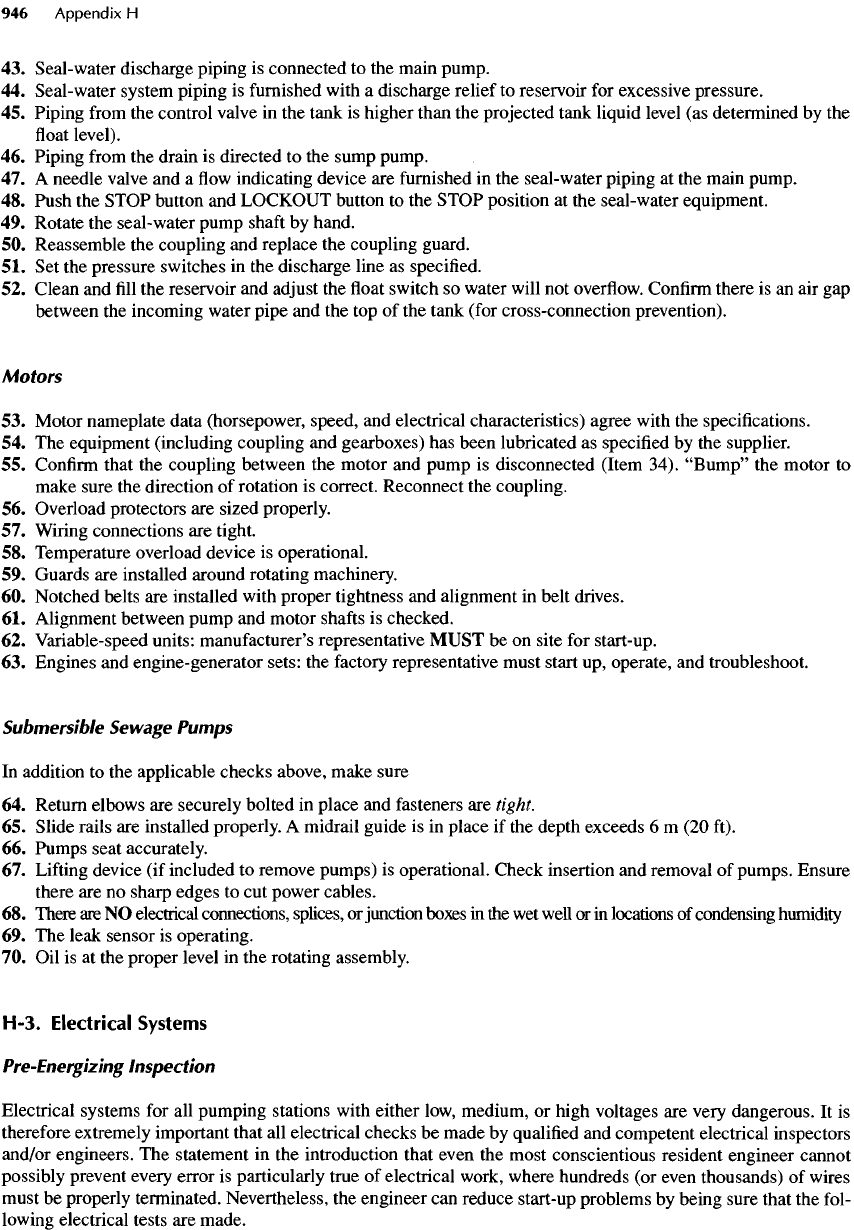
43.
Seal-water discharge piping
is
connected
to the
main pump.
44.
Seal-water system piping
is
furnished with
a
discharge relief
to
reservoir
for
excessive pressure.
45.
Piping
from
the
control valve
in the
tank
is
higher than
the
projected tank liquid level
(as
determined
by the
float
level).
46.
Piping
from
the
drain
is
directed
to the
sump pump.
47. A
needle valve
and a flow
indicating device
are
furnished
in the
seal-water
piping
at the
main pump.
48.
Push
the
STOP button
and
LOCKOUT button
to the
STOP
position
at the
seal-water equipment.
49.
Rotate
the
seal-water pump
shaft
by
hand.
50.
Reassemble
the
coupling
and
replace
the
coupling guard.
51. Set the
pressure switches
in the
discharge line
as
specified.
52.
Clean
and fill the
reservoir
and
adjust
the float
switch
so
water will
not
overflow.
Confirm
there
is an air gap
between
the
incoming water pipe
and the top of the
tank (for cross-connection prevention).
Motors
53.
Motor nameplate data (horsepower, speed,
and
electrical characteristics) agree with
the
specifications.
54. The
equipment (including coupling
and
gearboxes)
has
been lubricated
as
specified
by the
supplier.
55.
Confirm
that
the
coupling between
the
motor
and
pump
is
disconnected (Item 34).
"Bump"
the
motor
to
make
sure
the
direction
of
rotation
is
correct. Reconnect
the
coupling.
56.
Overload protectors
are
sized properly.
57.
Wiring connections
are
tight.
58.
Temperature overload device
is
operational.
59.
Guards
are
installed around rotating machinery.
60.
Notched belts
are
installed with proper tightness
and
alignment
in
belt drives.
61.
Alignment between pump
and
motor
shafts
is
checked.
62.
Variable-speed units: manufacturer's representative MUST
be on
site
for
start-up.
63.
Engines
and
engine-generator sets:
the
factory representative must start
up,
operate,
and
troubleshoot.
Submersible Sewage Pumps
In
addition
to the
applicable checks above, make sure
64.
Return elbows
are
securely bolted
in
place
and
fasteners
are
tight.
65.
Slide rails
are
installed properly.
A
midrail guide
is in
place
if the
depth exceeds
6 m (20
ft).
66.
Pumps seat accurately.
67.
Lifting
device
(if
included
to
remove pumps)
is
operational. Check insertion
and
removal
of
pumps. Ensure
there
are no
sharp edges
to cut
power cables.
68.
There
are NO
electrical connections, splices,
or
junction boxes
in the wet
well
or in
locations
of
condensing
humidity
69. The
leak sensor
is
operating.
70. Oil is at the
proper level
in the
rotating assembly.
H-3.
Electrical
Systems
Pre-Energizing Inspection
Electrical systems
for all
pumping stations with either low, medium,
or
high voltages
are
very dangerous.
It is
therefore
extremely important that
all
electrical checks
be
made
by
qualified
and
competent electrical inspectors
and/or engineers.
The
statement
in the
introduction that even
the
most conscientious resident
engineer
cannot
possibly prevent every error
is
particularly true
of
electrical work, where hundreds
(or
even thousands)
of
wires
must
be
properly terminated. Nevertheless,
the
engineer
can
reduce start-up problems
by
being sure that
the
fol-
lowing
electrical tests
are
made.
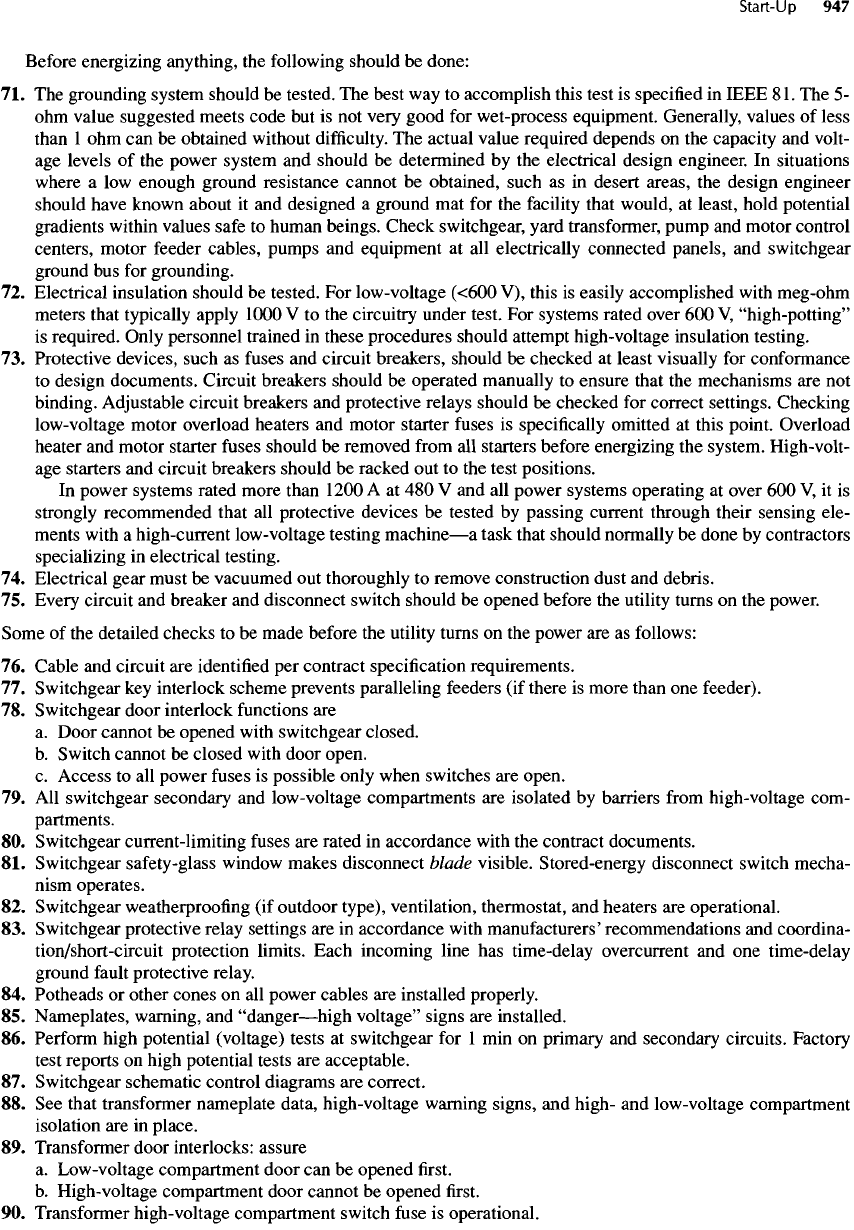
Before
energizing anything,
the
following should
be
done:
71. The
grounding system should
be
tested.
The
best
way to
accomplish this test
is
specified
in
IEEE
81.
The 5-
ohm
value suggested meets code
but is not
very good
for
wet-process equipment. Generally, values
of
less
than
1 ohm can be
obtained without
difficulty.
The
actual value required depends
on the
capacity
and
volt-
age
levels
of the
power system
and
should
be
determined
by the
electrical design engineer.
In
situations
where
a low
enough ground resistance cannot
be
obtained, such
as in
desert areas,
the
design engineer
should have known about
it and
designed
a
ground
mat for the
facility
that would,
at
least, hold potential
gradients
within
values
safe
to
human beings. Check switchgear, yard transformer, pump
and
motor control
centers, motor feeder cables, pumps
and
equipment
at all
electrically connected panels,
and
switchgear
ground
bus for
grounding.
72.
Electrical insulation should
be
tested.
For
low-voltage
(<600
V),
this
is
easily accomplished with meg-ohm
meters that typically apply 1000
V to the
circuitry under test.
For
systems rated over
600 V,
"high-potting"
is
required. Only personnel trained
in
these procedures should attempt high-voltage insulation testing.
73.
Protective devices, such
as
fuses
and
circuit breakers, should
be
checked
at
least visually
for
conformance
to
design documents. Circuit breakers should
be
operated manually
to
ensure that
the
mechanisms
are not
binding. Adjustable circuit breakers
and
protective relays should
be
checked
for
correct settings. Checking
low-voltage motor overload heaters
and
motor starter
fuses
is
specifically omitted
at
this point. Overload
heater
and
motor starter
fuses
should
be
removed
from
all
starters before energizing
the
system. High-volt-
age
starters
and
circuit breakers should
be
racked
out to the
test positions.
In
power systems rated more than 1200
A at 480 V and all
power systems operating
at
over
600 V, it is
strongly recommended that
all
protective
devices
be
tested
by
passing current through
their
sensing ele-
ments
with
a
high-current low-voltage testing
machine—a
task that should normally
be
done
by
contractors
specializing
in
electrical testing.
74.
Electrical gear must
be
vacuumed
out
thoroughly
to
remove construction dust
and
debris.
75.
Every circuit
and
breaker
and
disconnect switch should
be
opened before
the
utility turns
on the
power.
Some
of the
detailed checks
to be
made before
the
utility turns
on the
power
are as
follows:
76.
Cable
and
circuit
are
identified
per
contract specification requirements.
77.
Switchgear
key
interlock scheme prevents paralleling feeders
(if
there
is
more than
one
feeder).
78.
Switchgear door interlock
functions
are
a.
Door cannot
be
opened with switchgear closed.
b.
Switch cannot
be
closed
with door open.
c.
Access
to all
power
fuses
is
possible
only when switches
are
open.
79. All
switchgear secondary
and
low-voltage compartments
are
isolated
by
barriers
from
high-voltage com-
partments.
80.
Switchgear current-limiting
fuses
are
rated
in
accordance with
the
contract documents.
81.
Switchgear safety-glass window makes disconnect blade visible. Stored-energy disconnect switch mecha-
nism
operates.
82.
Switchgear
weatherproofing
(if
outdoor type), ventilation, thermostat,
and
heaters
are
operational.
83.
Switchgear protective relay settings
are in
accordance with manufacturers' recommendations
and
coordina-
tion/short-circuit protection limits. Each incoming line
has
time-delay
overcurrent
and one
time-delay
ground
fault
protective relay.
84.
Pomeads
or
other
cones
on all
power
cables
are
installed properly.
85.
Nameplates, warning,
and
"danger—high
voltage"
signs
are
installed.
86.
Perform high potential (voltage) tests
at
switchgear
for 1 min on
primary
and
secondary circuits. Factory
test reports
on
high potential tests
are
acceptable.
87.
Switchgear schematic control diagrams
are
correct.
88. See
that transformer nameplate data, high-voltage warning signs,
and
high-
and
low-voltage compartment
isolation
are in
place.
89.
Transformer door interlocks: assure
a.
Low-voltage compartment door
can be
opened
first.
b.
High-voltage compartment door cannot
be
opened
first.
90.
Transformer high-voltage compartment switch
fuse
is
operational.
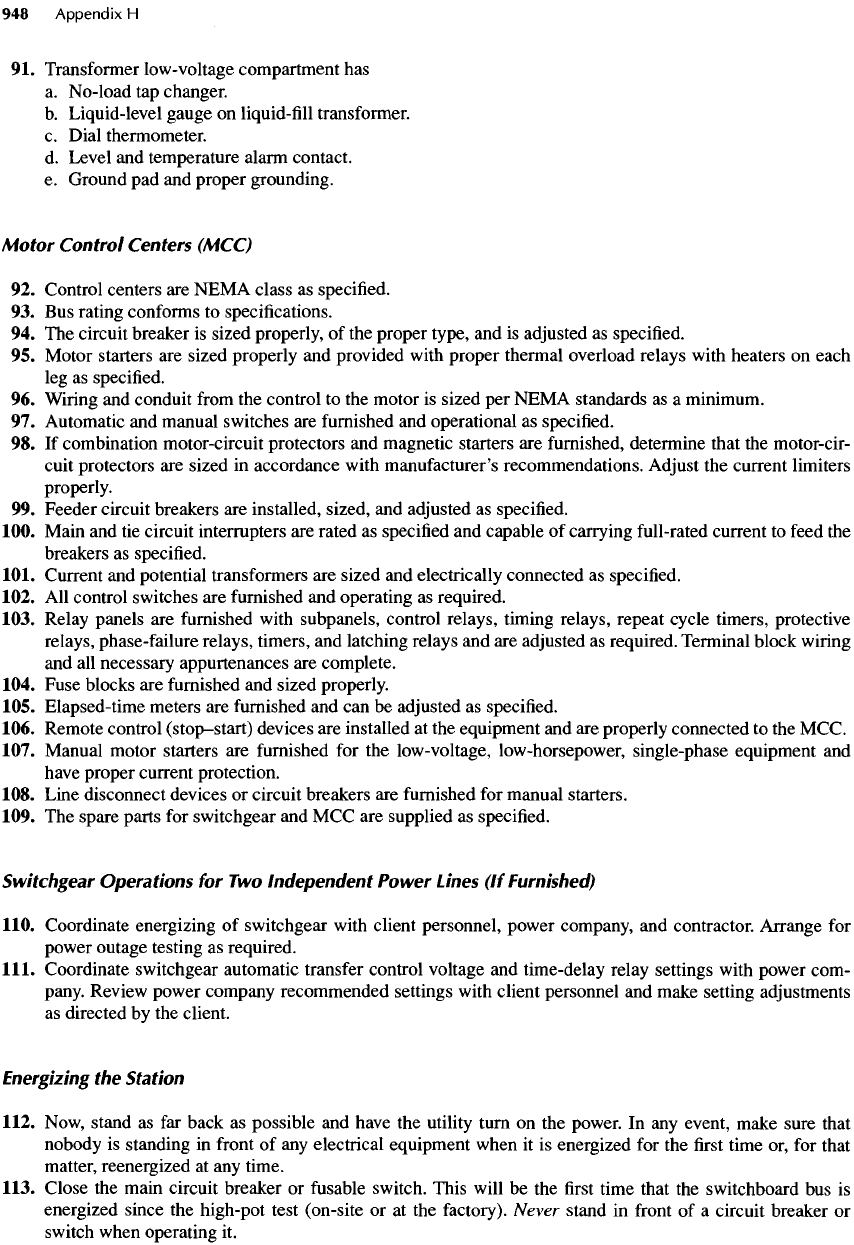
91.
Transformer
low-voltage
compartment
has
a.
No-load
tap
changer.
b.
Liquid-level gauge
on
liquid-fill transformer.
c.
Dial thermometer.
d.
Level
and
temperature alarm contact.
e.
Ground
pad and
proper grounding.
Motor
Control
Centers (MCC)
92.
Control centers
are
NEMA class
as
specified.
93. Bus
rating conforms
to
specifications.
94. The
circuit breaker
is
sized properly,
of the
proper type,
and is
adjusted
as
specified.
95.
Motor starters
are
sized properly
and
provided with proper thermal overload relays with heaters
on
each
leg as
specified.
96.
Wiring
and
conduit
from
the
control
to the
motor
is
sized
per
NEMA standards
as a
minimum.
97.
Automatic
and
manual switches
are
furnished
and
operational
as
specified.
98. If
combination motor-circuit
protectors
and
magnetic starters
are
furnished,
determine that
the
motor-cir-
cuit
protectors
are
sized
in
accordance with manufacturer's recommendations.
Adjust
the
current limiters
properly.
99.
Feeder circuit breakers
are
installed, sized,
and
adjusted
as
specified.
100. Main
and tie
circuit interrupters
are
rated
as
specified
and
capable
of
carrying
full-rated
current
to
feed
the
breakers
as
specified.
101. Current
and
potential transformers
are
sized
and
electrically connected
as
specified.
102.
All
control switches
are
furnished
and
operating
as
required.
103. Relay panels
are
furnished
with subpanels, control relays, timing relays, repeat cycle timers, protective
relays,
phase-failure relays, timers,
and
latching relays
and are
adjusted
as
required. Terminal block wiring
and
all
necessary appurtenances
are
complete.
104. Fuse blocks
are
furnished
and
sized properly.
105.
Elapsed-time
meters
are
furnished
and can be
adjusted
as
specified.
106. Remote control
(stop-start)
devices
are
installed
at the
equipment
and are
properly connected
to the
MCC.
107. Manual motor starters
are
furnished
for the
low-voltage, low-horsepower, single-phase equipment
and
have
proper current protection.
108. Line disconnect devices
or
circuit breakers
are
furnished
for
manual starters.
109.
The
spare parts
for
switchgear
and MCC are
supplied
as
specified.
Switchgear
Operations
for Two
Independent
Power
Lines
(If
Furnished)
110. Coordinate energizing
of
switchgear with client personnel, power company,
and
contractor. Arrange
for
power outage testing
as
required.
111. Coordinate switchgear automatic transfer control voltage
and
time-delay relay settings with power com-
pany.
Review power company recommended settings with client personnel
and
make setting adjustments
as
directed
by the
client.
Energizing
the
Station
112. Now, stand
as far
back
as
possible
and
have
the
utility turn
on the
power.
In any
event, make sure that
nobody
is
standing
in
front
of any
electrical
equipment when
it is
energized
for the first
time
or, for
that
matter,
reenergized
at any
time.
113. Close
the
main circuit breaker
or
fusable
switch. This will
be the first
time that
the
switchboard
bus is
energized since
the
high-pot test (on-site
or at the
factory).
Never stand
in
front
of a
circuit breaker
or
switch
when operating
it.
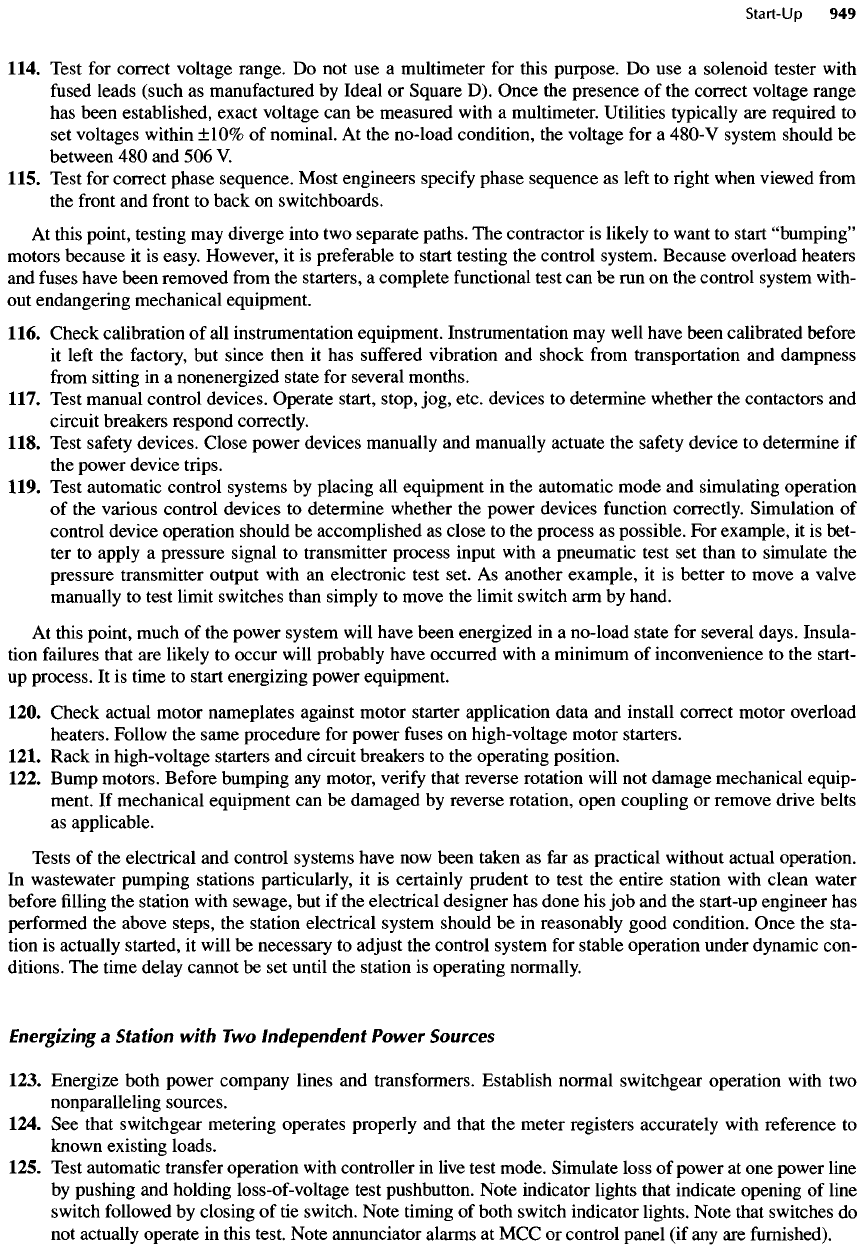
114. Test
for
correct voltage range.
Do not use a
multimeter
for
this purpose.
Do use a
solenoid tester with
fused
leads (such
as
manufactured
by
Ideal
or
Square
D).
Once
the
presence
of the
correct voltage range
has
been established, exact voltage
can be
measured with
a
multimeter. Utilities typically
are
required
to
set
voltages within
±10%
of
nominal.
At the
no-load condition,
the
voltage
for a
480-V
system should
be
between
480 and 506 V.
115. Test
for
correct phase sequence. Most engineers
specify
phase sequence
as
left
to right
when viewed
from
the
front
and
front
to
back
on
switchboards.
At
this point, testing
may
diverge into
two
separate paths.
The
contractor
is
likely
to
want
to
start
"bumping"
motors
because
it is
easy. However,
it is
preferable
to
start testing
the
control system. Because overload heaters
and
fuses
have been removed
from
the
starters,
a
complete functional test
can be run on the
control system with-
out
endangering mechanical equipment.
116. Check calibration
of all
instrumentation equipment. Instrumentation
may
well
have
been calibrated before
it
left
the
factory,
but
since then
it has
suffered
vibration
and
shock
from
transportation
and
dampness
from
sitting
in a
nonenergized state
for
several months.
117. Test manual control devices. Operate start, stop, jog, etc. devices
to
determine whether
the
contactors
and
circuit
breakers respond correctly.
118. Test
safety
devices. Close power devices manually
and
manually actuate
the
safety
device
to
determine
if
the
power device trips.
119. Test automatic control systems
by
placing
all
equipment
in the
automatic mode
and
simulating
operation
of
the
various control devices
to
determine whether
the
power devices
function
correctly. Simulation
of
control device operation should
be
accomplished
as
close
to the
process
as
possible.
For
example,
it is
bet-
ter
to
apply
a
pressure signal
to
transmitter process input with
a
pneumatic test
set
than
to
simulate
the
pressure transmitter output with
an
electronic test set.
As
another example,
it is
better
to
move
a
valve
manually
to
test limit switches than simply
to
move
the
limit switch
arm by
hand.
At
this point, much
of the
power system will have been energized
in a
no-load state
for
several days. Insula-
tion failures that
are
likely
to
occur will probably have occurred with
a
minimum
of
inconvenience
to the
start-
up
process.
It is
time
to
start energizing power equipment.
120. Check actual motor nameplates against motor starter application data
and
install correct motor overload
heaters. Follow
the
same procedure
for
power
fuses
on
high-voltage motor starters.
121. Rack
in
high-voltage starters
and
circuit breakers
to the
operating position.
122. Bump motors.
Before
bumping
any
motor,
verify
that reverse rotation will
not
damage mechanical equip-
ment.
If
mechanical equipment
can be
damaged
by
reverse rotation, open coupling
or
remove drive
belts
as
applicable.
Tests
of the
electrical
and
control systems have
now
been taken
as far as
practical without actual operation.
In
wastewater pumping stations particularly,
it is
certainly prudent
to
test
the
entire station with clean water
before
filling
the
station with sewage,
but if the
electrical designer
has
done
his job and the
start-up engineer
has
performed
the
above steps,
the
station electrical system should
be in
reasonably good condition. Once
the
sta-
tion
is
actually started,
it
will
be
necessary
to
adjust
the
control system
for
stable operation under dynamic con-
ditions.
The
time delay cannot
be set
until
the
station
is
operating normally.
Energizing
a
Station with
Two
Independent Power
Sources
123. Energize both power company lines
and
transformers. Establish normal switchgear operation
with
two
nonparalleling sources.
124.
See
that
switchgear metering operates properly
and
that
the
meter registers accurately
with
reference
to
known
existing loads.
125.
Test
automatic
transfer
operation with controller
in
live test mode. Simulate loss
of
power
at one
power line
by
pushing
and
holding
loss-of-voltage
test pushbutton. Note indicator lights that indicate opening
of
line
switch
followed
by
closing
of tie
switch. Note timing
of
both switch indicator lights. Note that switches
do
not
actually operate
in
this test. Note annunciator alarms
at MCC or
control panel
(if any are
furnished).
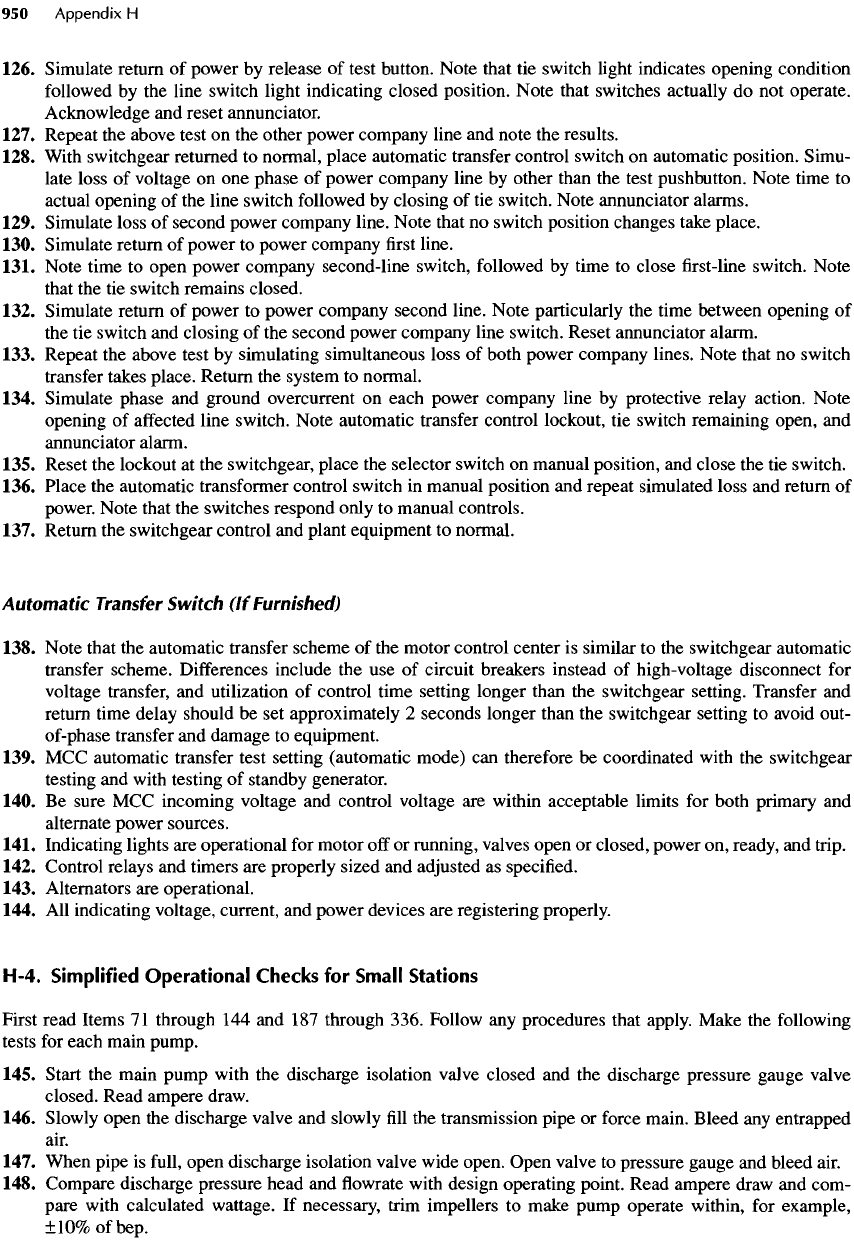
126. Simulate return
of
power
by
release
of
test button. Note that
tie
switch light indicates opening condition
followed
by the
line switch light indicating closed
position.
Note that switches actually
do not
operate.
Acknowledge
and
reset
annunciator.
127. Repeat
the
above test
on the
other power company line
and
note
the
results.
128. With switchgear returned
to
normal, place automatic transfer control switch
on
automatic position. Simu-
late loss
of
voltage
on one
phase
of
power company line
by
other than
the
test pushbutton. Note time
to
actual
opening
of the
line switch followed
by
closing
of tie
switch. Note annunciator alarms.
129. Simulate loss
of
second power company line. Note that
no
switch position changes take
place.
130.
Simulate return
of
power
to
power company
first
line.
131.
Note time
to
open power company second-line switch, followed
by
time
to
close
first-line
switch. Note
that
the tie
switch remains closed.
132.
Simulate return
of
power
to
power company second line. Note particularly
the
time between opening
of
the tie
switch
and
closing
of the
second power company
line
switch. Reset annunciator alarm.
133.
Repeat
the
above test
by
simulating simultaneous loss
of
both power company lines. Note that
no
switch
transfer
takes place. Return
the
system
to
normal.
134. Simulate phase
and
ground
overcurrent
on
each power company
line
by
protective relay action. Note
opening
of
affected
line switch. Note automatic transfer control lockout,
tie
switch remaining open,
and
annunciator alarm.
135.
Reset
the
lockout
at the
switchgear, place
the
selector switch
on
manual position,
and
close
the tie
switch.
136.
Place
the
automatic transformer control switch
in
manual position
and
repeat simulated loss
and
return
of
power. Note that
the
switches respond only
to
manual controls.
137.
Return
the
switchgear control
and
plant equipment
to
normal.
Automatic
Transfer
Switch
(If
Furnished)
138.
Note that
the
automatic
transfer
scheme
of the
motor control center
is
similar
to the
switchgear automatic
transfer
scheme. Differences include
the use of
circuit breakers instead
of
high-voltage
disconnect
for
voltage
transfer,
and
utilization
of
control time setting longer than
the
switchgear setting. Transfer
and
return
time delay should
be set
approximately
2
seconds longer than
the
switchgear setting
to
avoid out-
of-phase
transfer
and
damage
to
equipment.
139.
MCC
automatic transfer test setting (automatic mode)
can
therefore
be
coordinated with
the
switchgear
testing
and
with testing
of
standby generator.
140.
Be
sure
MCC
incoming voltage
and
control voltage
are
within acceptable limits
for
both primary
and
alternate power sources.
141. Indicating lights
are
operational
for
motor
off
or
running, valves open
or
closed,
power
on,
ready,
and
trip.
142. Control relays
and
timers
are
properly sized
and
adjusted
as
specified.
143. Alternators
are
operational.
144.
All
indicating voltage, current,
and
power devices
are
registering properly.
H-4. Simplified Operational
Checks
for
Small
Stations
First read Items
71
through
144 and 187
through
336.
Follow
any
procedures that apply. Make
the
following
tests
for
each main pump.
145. Start
the
main pump with
the
discharge isolation valve closed
and the
discharge pressure gauge valve
closed. Read ampere draw.
146. Slowly open
the
discharge valve
and
slowly
fill the
transmission pipe
or
force main. Bleed
any
entrapped
air.
147. When pipe
is
full,
open discharge isolation valve wide open. Open valve
to
pressure gauge
and
bleed
air.
148. Compare discharge pressure head
and flowrate
with design operating point. Read ampere draw
and
com-
pare with calculated wattage.
If
necessary, trim impellers
to
make pump operate within,
for
example,
±10%ofbep.
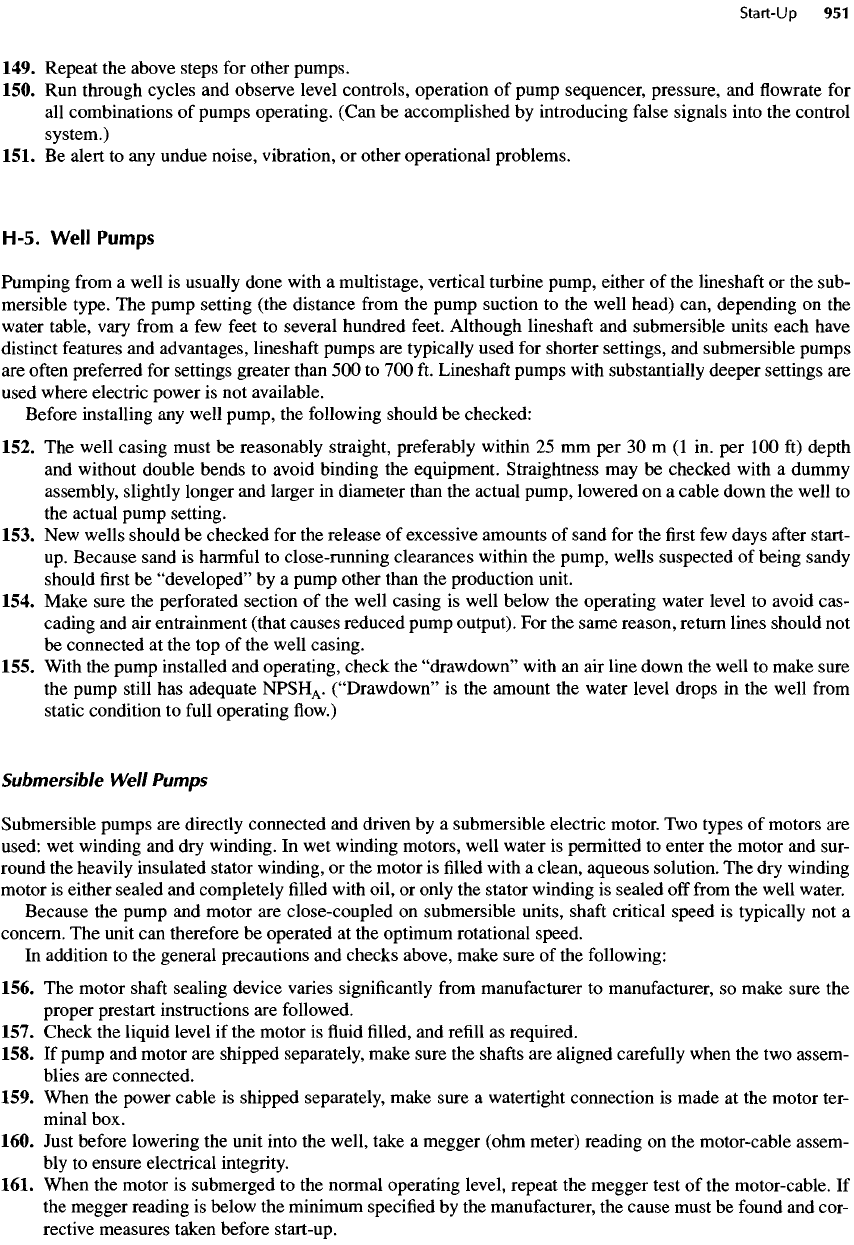
149. Repeat
the
above steps
for
other pumps.
150.
Run
through cycles
and
observe level controls, operation
of
pump sequencer, pressure,
and flowrate for
all
combinations
of
pumps operating. (Can
be
accomplished
by
introducing false signals
into
the
control
system.)
151.
Be
alert
to any
undue
noise,
vibration,
or
other operational problems.
H-5.
Well
Pumps
Pumping
from
a
well
is
usually done with
a
multistage, vertical turbine pump, either
of the
lineshaft
or the
sub-
mersible type.
The
pump setting (the distance
from
the
pump suction
to the
well head) can, depending
on the
water
table, vary
from
a few
feet
to
several hundred
feet.
Although lineshaft
and
submersible units each have
distinct
features
and
advantages, lineshaft pumps
are
typically used
for
shorter settings,
and
submersible pumps
are
often
preferred
for
settings greater than
500 to 700 ft.
Lineshaft pumps with substantially
deeper
settings
are
used
where electric power
is not
available.
Before
installing
any
well pump,
the
following should
be
checked:
152.
The
well casing must
be
reasonably straight, preferably within
25 mm per
3Om(I
in. per 100 ft)
depth
and
without double bends
to
avoid binding
the
equipment. Straightness
may be
checked with
a
dummy
assembly,
slightly longer
and
larger
in
diameter than
the
actual pump, lowered
on a
cable down
the
well
to
the
actual pump setting.
153.
New
wells should
be
checked
for the
release
of
excessive amounts
of
sand
for the first few
days
after
start-
up.
Because sand
is
harmful
to
close-running clearances within
the
pump, wells suspected
of
being sandy
should
first be
"developed"
by a
pump other than
the
production unit.
154. Make sure
the
perforated section
of the
well casing
is
well below
the
operating water level
to
avoid cas-
cading
and air
entrainment (that causes reduced pump output).
For the
same reason, return lines should
not
be
connected
at the top of the
well casing.
155. With
the
pump installed
and
operating, check
the
"drawdown"
with
an air
line
down
the
well
to
make sure
the
pump still
has
adequate
NPSH
A
.
("Drawdown"
is the
amount
the
water level drops
in the
well
from
static condition
to
full
operating
flow.)
Submersible
Well
Pumps
Submersible pumps
are
directly connected
and
driven
by a
submersible
electric
motor.
Two
types
of
motors
are
used:
wet
winding
and dry
winding.
In wet
winding motors, well water
is
permitted
to
enter
the
motor
and
sur-
round
the
heavily insulated stator winding,
or the
motor
is filled
with
a
clean, aqueous solution.
The dry
winding
motor
is
either
sealed
and
completely
filled
with oil,
or
only
the
stator winding
is
sealed
off
from
the
well water.
Because
the
pump
and
motor
are
close-coupled
on
submersible units,
shaft
critical speed
is
typically
not a
concern.
The
unit
can
therefore
be
operated
at the
optimum rotational speed.
In
addition
to the
general precautions
and
checks above, make sure
of the
following:
156.
The
motor
shaft
sealing device varies
significantly
from
manufacturer
to
manufacturer,
so
make sure
the
proper
prestart
instructions
are
followed.
157. Check
the
liquid level
if the
motor
is fluid filled, and
refill
as
required.
158.
If
pump
and
motor
are
shipped separately, make sure
the
shafts
are
aligned carefully when
the two
assem-
blies
are
connected.
159. When
the
power cable
is
shipped separately, make sure
a
watertight connection
is
made
at the
motor ter-
minal box.
160. Just before lowering
the
unit into
the
well, take
a
megger (ohm meter) reading
on the
motor-cable assem-
bly
to
ensure electrical integrity.
161. When
the
motor
is
submerged
to the
normal operating level, repeat
the
megger test
of the
motor-cable.
If
the
megger reading
is
below
the
minimum specified
by the
manufacturer,
the
cause must
be
found
and
cor-
rective measures taken before start-up.
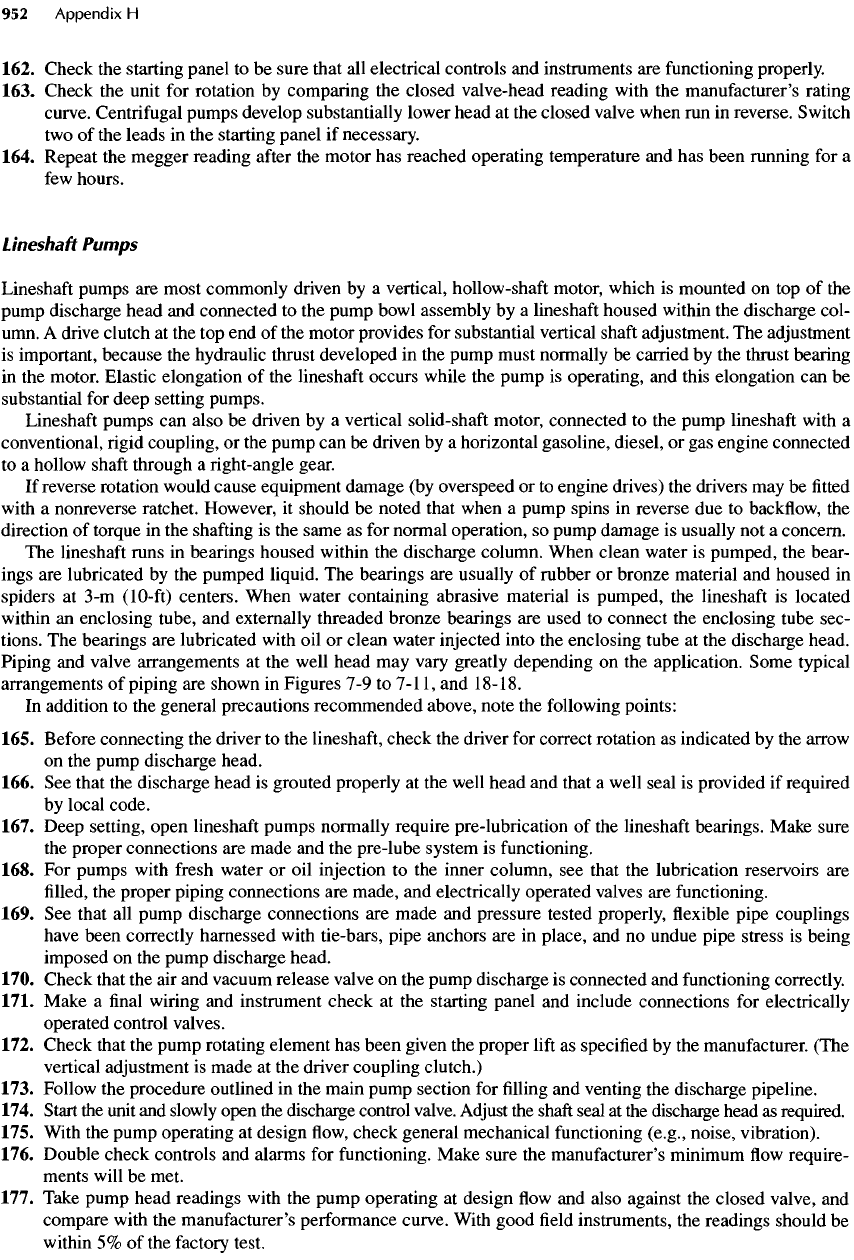
162. Check
the
starting panel
to be
sure that
all
electrical
controls
and
instruments
are
functioning properly.
163. Check
the
unit
for
rotation
by
comparing
the
closed valve-head reading with
the
manufacturer's rating
curve.
Centrifugal pumps develop substantially lower head
at the
closed valve when
run in
reverse. Switch
two
of the
leads
in the
starting panel
if
necessary.
164. Repeat
the
megger reading
after
the
motor
has
reached operating temperature
and has
been running
for a
few
hours.
Lineshaft
Pumps
Lineshaft
pumps
are
most commonly driven
by a
vertical, hollow-shaft motor, which
is
mounted
on top of the
pump
discharge head
and
connected
to the
pump bowl assembly
by a
lineshaft housed within
the
discharge col-
umn.
A
drive clutch
at the top end of the
motor provides
for
substantial vertical
shaft
adjustment.
The
adjustment
is
important, because
the
hydraulic thrust developed
in the
pump must normally
be
carried
by the
thrust bearing
in
the
motor. Elastic elongation
of the
lineshaft occurs while
the
pump
is
operating,
and
this elongation
can be
substantial
for
deep setting pumps.
Lineshaft
pumps
can
also
be
driven
by a
vertical solid-shaft motor, connected
to the
pump lineshaft with
a
conventional, rigid coupling,
or the
pump
can be
driven
by a
horizontal gasoline, diesel,
or gas
engine connected
to a
hollow
shaft
through
a
right-angle
gear.
If
reverse rotation would cause equipment damage
(by
overspeed
or to
engine drives)
the
drivers
may be
fitted
with
a
nonreverse ratchet. However,
it
should
be
noted that when
a
pump spins
in
reverse
due to
backflow,
the
direction
of
torque
in the
shafting
is the
same
as for
normal operation,
so
pump damage
is
usually
not a
concern.
The
lineshaft runs
in
bearings housed within
the
discharge column. When clean water
is
pumped,
the
bear-
ings
are
lubricated
by the
pumped liquid.
The
bearings
are
usually
of
rubber
or
bronze material
and
housed
in
spiders
at
3-m
(10-ft)
centers. When water containing abrasive material
is
pumped,
the
lineshaft
is
located
within
an
enclosing tube,
and
externally threaded bronze bearings
are
used
to
connect
the
enclosing tube sec-
tions.
The
bearings
are
lubricated with
oil or
clean water injected into
the
enclosing tube
at the
discharge head.
Piping
and
valve arrangements
at the
well head
may
vary greatly depending
on the
application. Some typical
arrangements
of
piping
are
shown
in
Figures
7-9 to
7-11,
and
18-18.
In
addition
to the
general precautions recommended above, note
the
following points:
165. Before connecting
the
driver
to the
lineshaft, check
the
driver
for
correct rotation
as
indicated
by the
arrow
on
the
pump discharge head.
166.
See
that
the
discharge head
is
grouted properly
at the
well head
and
that
a
well seal
is
provided
if
required
by
local code.
167. Deep setting, open lineshaft pumps normally require
pre-lubrication
of the
lineshaft bearings. Make sure
the
proper connections
are
made
and the
pre-lube
system
is
functioning.
168.
For
pumps with
fresh
water
or oil
injection
to the
inner column,
see
that
the
lubrication reservoirs
are
filled,
the
proper piping connections
are
made,
and
electrically operated valves
are
functioning.
169.
See
that
all
pump discharge connections
are
made
and
pressure tested properly,
flexible
pipe
couplings
have
been correctly harnessed with tie-bars, pipe anchors
are in
place,
and no
undue pipe stress
is
being
imposed
on the
pump discharge head.
170. Check that
the air and
vacuum release valve
on the
pump discharge
is
connected
and
functioning correctly.
171. Make
a final
wiring
and
instrument check
at the
starting panel
and
include connections
for
electrically
operated control valves.
172. Check that
the
pump rotating element
has
been given
the
proper
lift
as
specified
by the
manufacturer. (The
vertical
adjustment
is
made
at the
driver coupling clutch.)
173. Follow
the
procedure outlined
in the
main pump section
for filling and
venting
the
discharge pipeline.
174. Start
the
unit
and
slowly open
the
discharge control valve.
Adjust
the
shaft
seal
at the
discharge head
as
required.
175. With
the
pump operating
at
design
flow,
check general mechanical functioning (e.g., noise, vibration).
176. Double check controls
and
alarms
for
functioning.
Make sure
the
manufacturer's minimum
flow
require-
ments
will
be
met.
177. Take pump head readings with
the
pump operating
at
design
flow and
also against
the
closed
valve,
and
compare with
the
manufacturer's performance curve. With good
field
instruments,
the
readings should
be
within
5% of the
factory test.
